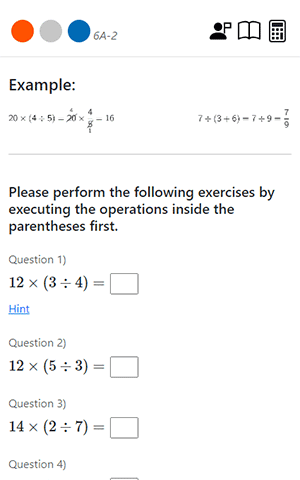

On this page, we’ll explore the Order of Operations, a key math rule that ensures everyone arrives at the same answer when performing calculations.
The Order of Operations is a set of rules that tells us the correct sequence when performing calculations with multiple operations (mixtures of addition, subtraction, multiplication, division, etc.).
Following these rules ensures that everyone gets the same answer every time.
For example: $$2+3\times 4$$
Since the two methods give different answers, "the order of operations" must be established to ensure everyone knows which steps to perform first. (The order of operations is, therefore, simply a universal agreement that everyone follows.)
Remember "Please Excuse My Dear Aunt Sally (PEMDAS)"
$2\times (5+3)=2\times \underbrace{\color{red}(5+3)}_{①}=2\times {\color{red}8}=16$
${\color{red}(5+3)}$ is performed first because it is inside the Parentheses.
$2+3\times 4=2+\underbrace{\color{red}3\times 4}_{①}=2+{\color{red}12}=14$
${\color{red}3\times 4}$ is performed first because Multiplication and Division (Step 3.) are done before Addition and Subtraction (Step 4.)
$(2+3)\times 4=\underbrace{\color{red}(2+3)}_{①}\times 4={\color{red}5}\times 4=20$
${\color{red}(2+3)}$ is performed first because the Parentheses (Step 1.) is done before Multiplication and Division (Step 3.)
Please compare this example with Example 2.
$30\div 5\times 3=\underbrace{\color{red}30\div 5}_{①}\times 3={\color{red}6}\times 3=18$
${\color{red}30\div 5}$ is performed first because Multiplication and Division (Step 3.) is done from left to right. If we do it differently, we will get the wrong answer, as shown below.
$30\div {\color{red}5\times 3}=30\div {\color{red}15}=2$ ("Wrong")
$20\div 2+8\times 3=\underbrace{\color{red}20\div 2}_{①}+\underbrace{\color{red}8\times 3}_{①}=10+24=34$
Each Multiplication and Division (Step 3.) at these 2 places are done before Addition and Subtraction (Step 4.)
$21-20\div 2+3=21-\underbrace{\color{red}20\div 2}_{①}+3=\underbrace{21-{\color{red}10}}_{②}+3=11+3=14$
Multiplication and Division (Step 3.) is done before Addition and Subtraction (Step 4.) from left to right
$21-20\div (2+3)=21-20\div \underbrace{\color{red}(2+3)}_{①}=21-\underbrace{20\div {\color{red}5}}_{②}=21-4=17$
Compared to Example 6, $\color{red}(2+3)$ is performed first because it is inside the Parentheses.

Our platform offers a range of expertly designed resources to help students excel in the Order of Operations. With detailed explanations, hints and practical examples, each resource is crafted to deepen understanding and support effective learning. Dive into our materials today and boost your math skills!